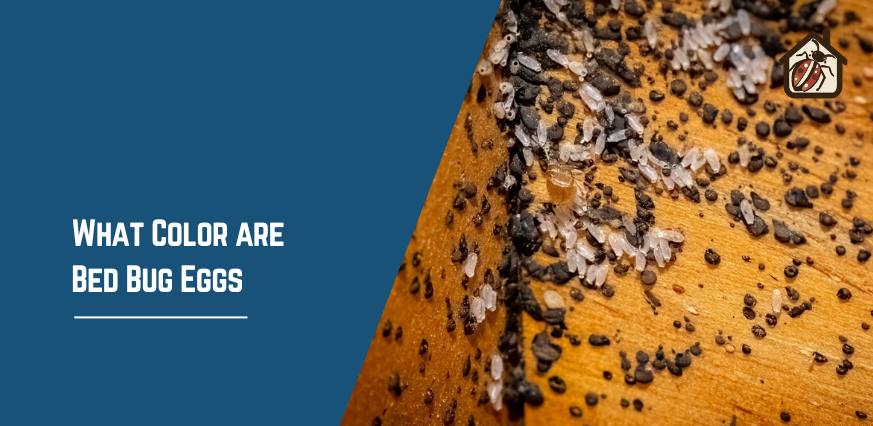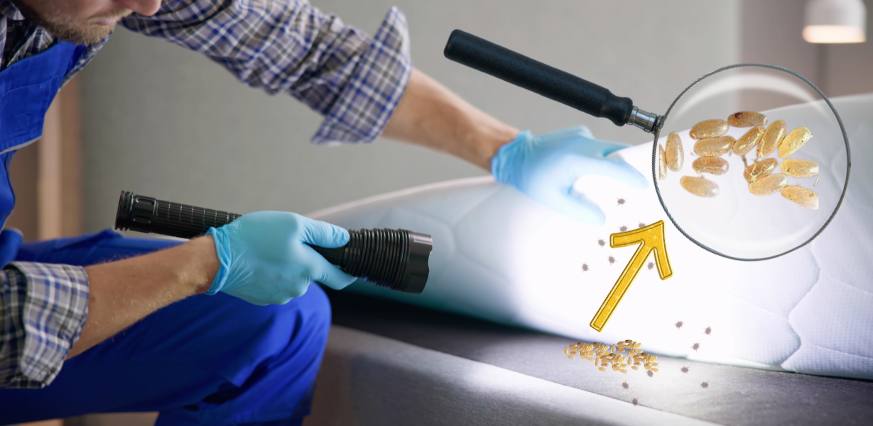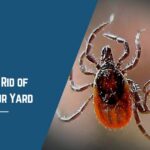
Because of their stealthy and hardy appearance, bed bugs present a special problem for homes that might unintentionally be harboring these uninvited visitors. The discomfort and possible health hazards that come with having a bed bug infestation highlight how urgent it is to find critical indicators, and the existence of their eggs is one such important indicator.
The color of the bed bug eggs ranges from pearl-white to pale yellow. These eggs, which are typically hidden in plain sight, are a signpost of the spread of an infestation, thus people must learn more about the subtleties of their appearance and life cycle.
Eggs laid by bed bugs are one of the primary clues that indicate the existence of an infestation. In the fight against these elusive insects, a thorough grasp of the color and characteristics of bed bug eggs becomes crucial, offering homeowners valuable insights for timely intervention.
How to spot bed bug eggs?

How to spot bed bug eggs
The Transparent Inception
Because finding bed bugs is difficult and are skilled at covertly invading homes, it’s critical to identify early warning signs, especially the existence of their eggs. Homeowners must understand the subtle differences in these tiny eggs’ appearance since they are vital to continuing bed bug infestations.
Newly produced bed bug eggs are tough to find because of their transparent or pearly white hue, which makes them almost invisible, particularly on light-colored surfaces like box springs or mattress seams. These are tiny eggs that resemble pinheads or rice grains, each measuring only one millimeter in length. Because of their light color, they may blend in well with their surroundings, adding another level of complexity to the already challenging task of identification.
A Change in Hue
The color of bed bug eggs varies subtly with age, adding another level of difficulty to the identification process. The eggs are translucent at first, but they become slightly more opaque and take on shades of cream or light tan.
Though substantial, this color shift might not be immediately apparent because of the tiny size of the eggs. The difficulty in finding these small eggs emphasizes the value of a careful check, particularly in locations where bed bugs are known to hide.
A Startling Hint about Development
A crucial distinguishing characteristic of bed bug eggs becomes visible during the fifth day after laying—a distinctive dark red “eye spot.” This characteristic area denotes the nymph’s development inside the egg and offers important insight into the pests’ life cycle.
Although this trait can be a useful indicator, identifying it needs careful, in-depth examination. The entire hatching process takes place over 7–10 days, and all of the eggs in a cluster usually hatch within this time frame, highlighting the critical need for prompt and comprehensive action.
Where do bed bugs lay eggs?
- Mattress folds and seams: These voids are ideal for laying eggs because they offer warmth and protection.
- Box spring tufts and seams: Just like mattresses, they provide safe havens for eggs.
- Headboards: particularly those close to the wall Headboards are desirable places since they are close to a food source.
- Behind dressers and nightstands: Cracks near the bed are excellent places for eggs to hatch.
- Clothes, backpacks, and luggage: During storage or travel, eggs may stow away and spread the infestation.
What do bed bug eggs look like?

- Form: Round or coiled in shape.
- Color: Color ranges from pearl-white to pale yellow.
- Dimensions: Approximately the size of a pinhead.
- Texture: When first laid, slightly shiny.
- Clustering: Groups of 10 to 50 bed bug eggs are frequently discovered.
- Adhesive coating: Applied to surfaces using a material akin to glue.
What should you do when you find bed bug eggs?
- Eggshells and nymphs can spread if the eggs are crushed or squashed.
- Bag and tightly seal contaminated things, such as bedding, and isolate the affected area.
- To ensure a secure and efficient removal, get in touch with a professional pest control agency.
You may also like:
FAQs
Why are bed bugs considered a challenging problem for homes?
What are the potential health hazards associated with a bed bug infestation?
How do bed bug eggs serve as a critical indicator of an infestation?
What makes it difficult to spot newly laid bed bug eggs, and where are they typically found?
How does the color of bed bug eggs change as they age, and why might this shift be challenging to notice?
Where are common hiding spots for bed bug eggs in a home?
What are the recommended actions when bed bug eggs are discovered, and why is professional pest control engagement crucial for successful eradication?
Conclusion
In conclusion, a diversified strategy for identification and management is necessary due to the complex and enduring nature of bed bug infestations. It’s important to recognize the possible consequences of mishandling these fragile organisms in addition to deciphering the minute details like the color of bed bug eggs and the texture of bed bug eggs.
Squash or crush the eggs to prevent the spread of nymphs and eggshells, which would prolong the infestation. To prevent the unintentional spread of these hardy pests, prompt action is needed. This involves carefully bagging and securely sealing infected items, especially bedding, and isolating the affected area. Nevertheless, given the intrinsic complexity of bed insect infestations, lone attempts might not be sufficient.
One essential element of a successful eradication campaign is the engagement of expert pest control services. With their extensive training, expertise, and specific tools, these professionals guarantee a safe and efficient removal procedure. By taking an all-encompassing strategy, homeowners protect the long-term integrity of their living spaces and quickly address the acute problems brought on by bed bug infestations, creating a pest-free environment that puts comfort and well-being first.


